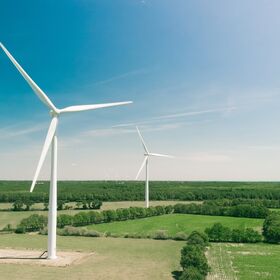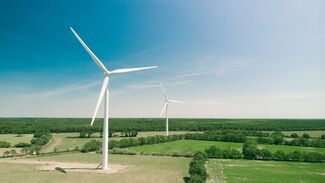“Renewables have now reached a tipping point”
Managers discuss key opportunities and risks.

Managers discuss key opportunities and risks.

Investment companies in the Renewable Energy Infrastructure sector have raised £7.7bn1 over the past five years, ahead of every other AIC sector. Investors have been attracted to the strong yields and opportunity to invest in a greener future, and with more countries and businesses targeting net-zero around the world, the prospects for renewable infrastructure look bright.
But this is also a fast-changing sector, with the uncertainty of power prices presenting risks. The Association of Investment Companies (AIC) has spoken to managers from the Renewable Energy Infrastructure sector about the main themes, opportunities and challenges facing investors.
What green theme are you most excited about?
James Armstrong, Managing Partner of Bluefield Partners LLP and Investment Adviser to Bluefield Solar Income Fund, said: “The ongoing cost reduction of installing renewable energy, specifically solar and wind, means that producing renewable energy is now becoming cost competitive with fossil fuels. Combined with government support for low carbon technologies this will result in a significant increase in renewable and storage technologies on the UK’s energy system over the coming decade which will be good for consumers and good for the environment. It heralds a multi-year investment opportunity for the Bluefield Solar Income Fund, which has consistently been one of the highest performers in the renewables sector since its IPO in 2013.”
Richard Crawford, Director of Infrastructure at InfraRed Capital Partners, the investment manager of The Renewables Infrastructure Group (TRIG), said: “What we find most exciting is the ambitious decarbonisation targets that governments in our core markets across the UK and Europe have set themselves. This has required and will continue to require massive investment in clean energy production – wind turbines, solar farms and supporting grid and storage infrastructure – exactly the sort of assets we like to invest in – as well as the continuing electrification of energy usage.
“At the same time, retail and institutional investors are also looking to decarbonise – in this instance, their own investment portfolios. They want to invest in companies that have strict ESG criteria – companies such as TRIG. We’re helping to meet that demand through our fundraises, where we sell shares to fund our investments in more clean energy projects. Our most recent £240 million fundraise will be used to pay for our stake in Scotland’s biggest operational offshore wind farm ‘Beatrice’, whose 84 giant turbines produce enough clean energy to power 450,000 homes. In total, our portfolio of 77 assets can produce enough clean power for 1.1 million homes, saving more than 1.2 million tonnes of CO2 emissions every year.”
Ricardo Piñeiro, Partner at Foresight Group, the investment manager of Foresight Solar Fund Limited (FSFL), said: “The most exciting development in the UK and European solar sectors and therefore for our portfolio is the ongoing commitment to decarbonised economies in the markets the company operates in, and the emergence of subsidy-free solar. This trend is expected to create an attractive environment for further investment in solar power plants in the UK and internationally, either through renewable energy support mechanisms or increasingly on a subsidy-free basis.
“Solar projects in the past usually required the support of government subsidies to make investment returns attractive enough to attract private investors such as FSFL. However, the combination of decreasing installation and operating costs combined with the ability to sell electricity under long-term contracts with energy offtakers has led to a new wave of solar construction. This new wave of subsidy-free projects is set to boost the penetration of renewables in energy markets across Europe in the coming years and contribute meaningfully towards national decarbonisation efforts. The emergence of the subsidy-free sector is likely to lead to a healthy pipeline of attractive investment opportunities for FSFL.”
Ben Guest, Manager of Gresham House Energy Storage Fund, said: “Renewables have now reached the tipping point whereby additional power generation will create oversupply, while also reducing the market available for baseload energy. This is forcing baseload generation out of existence and creating a deeper trough when renewables are not able to generate. The shrinking of consistent baseload energy is increasing the need for flexible generation – made possible through battery storage. As the market share of renewable energy grows, the amount of temporary excess generation will get worse. Thus, there is an urgent need for battery storage capacity to catch up to and keep up with renewable generation. By our estimates, instances of more than 10GW of excess power will occur frequently within the next four years – requiring 10GW of energy storage. In ten years, this could reach 30GW.”
Risks to the sector
Chris Tanner, Co-Lead Investment Advisor to JLEN Environmental Assets Group, said: “The long-term outlook for power prices is a key risk for the sector. This will be impacted by various macro trends, such as increased supply of electricity from the roll-out of renewables meeting increased demand from the electrification of transport and other sectors of the economy, including production of green hydrogen. At JLEN we think diversification is one method of dealing with this uncertainty, as not all our assets generate electricity and therefore the portfolio has less exposure to merchant power prices.”
Ricardo Piñeiro, Partner at Foresight Group, the investment manager of Foresight Solar Fund Limited (FSFL), said: “The primary risk to any energy generator centres around the price at which it can sell the electricity it generates, with solar being no exception to this. However, given its renewable energy generation focus FSFL benefits from government subsidies across the vast majority of its assets and actively manages its remaining merchant electricity price exposure through a combination of long-term power price agreements and short- to medium-term fixed price agreements. This combination of government subsidies and fixed price agreements enables FSFL to benefit from a high degree of contracted revenues delivering stable and predictable cashflows which enable the company to meet its dividend targets.”
Richard Crawford, Director of Infrastructure at InfraRed Capital Partners, the investment manager of The Renewables Infrastructure Group (TRIG), said: “A risk to the sector is the oversupply of renewable electricity ahead of an expected increase in demand as a result of government targets, such as the UK government’s commitment to quadrupling offshore wind capacity by 2030. Flooding the market with a plentiful supply of renewable electricity from new farms without supporting demand for the power produced risks pushing down returns for operators, and their investors, imperilling future investment. It is therefore good to see the government begin to adopt a ‘whole economy’ approach to decarbonisation – by looking beyond power generation to other sectors of the economy such as transport and heating. This will require adequate rollout of electric vehicle charging infrastructure and the uptake and use of green hydrogen, produced through electrolysis and powered by renewable electricity, in homes and industry.”
How do you see your portfolio evolving over the next five years?
Alex O’Cinneide, CEO of Gore Street Energy Storage Fund (GSF), said: “The portfolio is expected to evolve through three key channels: asset size, asset location, and asset revenue streams. The fund’s target acquisition size is already in the region of 50MW+, a significant increase when compared with the fund’s first acquisition of 6MW, which was the biggest of its kind in Great Britain at the time of commission. With significantly larger sites, the fund is exposed to greater cashflows and increases the expected deployment schedule. With regards to the assets’ location, GSF currently has its entire portfolio of 440MW based in Great Britain and Ireland. Our intention is to diversify through the acquisition of large-scale battery sites in North America and Western Europe. This move would introduce the fund to new markets and associated revenue streams, as well as increase its exposure as a global player in energy storage.”
Michael Anderson, Senior Manager Partnerships & Portfolio Management at Aquila Capital, the investment adviser to the Aquila European Renewables Income Fund, said: “Our goal as we set out in the IPO of the Aquila European Renewables Income Fund in 2019 was to target a balanced portfolio of renewables across wind, solar and hydropower, with a long-term target of 30-50% in wind, 30-50% in solar and 15-25% in hydropower. The portfolio had been initially allocated to wind and hydropower up until September 2020, when we allocated to our first solar opportunity in Portugal and since that time have added two more solar assets to the portfolio. We will continue to pursue our objective of a balanced, diversified portfolio, targeting assets which not only fit our strict investment policy but also complement the existing portfolio. The portfolio’s assets are currently represented in six countries throughout Europe and we expect to expand on that over time. We expect energy storage to play an increasingly important role in power systems worldwide as the roll out of renewable energy continues, which increases the need for cost effective grid balancing.”
Providing stable income
Alex O’Cinneide, CEO of Gore Street Energy Storage Fund, said: “Gore Street is committed to providing a 7% dividend to investors per annum and has successfully achieved this target every year since the fund’s inception. Gore Street maintains a conservative strategy with its assets and is exposed to a diverse set of revenue streams with several contract lengths which can be switched between and/or stacked against each other depending on market prices. Gore Street’s performance is evidenced by its strong growth and consistent dividend payments throughout the Covid-19 pandemic.”
Michael Anderson, Senior Manager Partnerships & Portfolio Management at Aquila Capital, the investment adviser to the Aquila European Renewables Income Fund, said: “The investment strategy of the Aquila European Renewables Income Fund remains unchanged since the IPO in 2019 and accordingly we remain committed to developing a diversified multi-technology portfolio of wind, hydropower and solar assets across Europe (excluding the United Kingdom). The multi-technology approach, combined with country diversification helps to stabilise the seasonality of production throughout the year and minimise any reliance on a single power market. We target assets which have long operating lives and are supported by a high degree of contracted revenues in the form of power purchase agreements and governmental subsidies, supported by high quality counterparties. Accordingly, the company’s portfolio has a high degree of earnings visibility, thus offering attractive risk adjusted returns for investors.”
The pace of renewable energy adoption
Whitney Voûte, Head of Investor Relations at US Solar Fund, said: “The US is one of the world's most established and attractive investment markets for solar power production, with supportive regulatory and policy frameworks, excellent conditions for solar in much of the country, and a deep market for long-term power purchase agreements. Power purchase agreements provide power price certainty to investment-grade corporate offtakers and reliable cashflows to solar investors. With President Biden making bold fiscal policy commitments to back his administration’s climate change pledges, the US has established a clear path to carbon-free electricity generation within 14 years. These are welcome plans which will further support the already buoyant solar sector. However, delivering them in this short timeframe means an urgent need for even more capital to accelerate the roll-out of utility scale solar power and other renewables.”
Chris Tanner, Co-Lead Investment Advisor to JLEN Environmental Assets Group, said: “In the Europe and the USA, renewable capacity is being added at a greater rate than fossil fuel capacity. In other parts of the world this is not the case, but in the medium term we expect that renewable generators will become the electricity plant of choice in these markets too. With this increased roll-out of renewables, issues around intermittency will become more prominent, and so we also expect further focus on carbon capture usage and storage to decarbonise baseload generation, as well as technologies to enable grids to handle the added complexity.”
James Armstrong, Managing Partner of Bluefield Partners LLP and Investment Adviser to Bluefield Solar Income Fund, said: “We believe the coming decade will see renewables being adopted at a faster pace than ever seen previously and on a scale that will transition the UK energy system to be supplied, primarily, by renewable energy and supported by storage solutions. This is because of a confluence of factors combining to provide irresistible momentum: the lowering cost of renewables makes it the most economic option and government support and public pressure creates the scale and the impetus. The 2020s will be the decade of renewables and storage and should provide the platform for a net zero energy system.”
Top fundraising investment company sectors in the five years to 14 April 2021
|
AIC sector |
IPOs (£m) |
Secondary fundraising (£m) |
Total fundraising (£m) |
|---|---|---|---|
|
Renewable Energy Infrastructure |
1,670.5 |
6,052.3 |
7,722.8 |
|
Infrastructure |
670.0 |
4,737.4 |
5,407.4 |
|
Property - UK Residential |
1,220.6 |
1,225.8 |
2,446.4 |
|
Global Smaller Companies |
822.5 |
1,303.4 |
2,125.9 |
|
Property - UK Commercial |
238.2 |
1,847.4 |
2,085.5 |
Source: AIC. From 1 April 2016 to 14 April 2021. Excludes VCTs and shares issued from treasury.
-ENDS-
Follow us on Twitter @AICPRESS
Notes to editors
- £7,722.8mn comprises £6,052.3mn in secondary fundraising and £1,670.5mn raised from IPOs between 1 April 2016 and 14 April 2021. Excludes VCTs and shares issued from treasury. Source: AIC.
- The Association of Investment Companies (AIC) was founded in 1932 to represent the interests of the investment trust industry – the oldest form of collective investment. Today, the AIC represents a broad range of closed-ended investment companies, incorporating investment trusts and other closed-ended investment companies and VCTs. The AIC’s members believe that the industry is best served if it is united and speaks with one voice. The AIC’s mission statement is to help members add value for shareholders over the longer term. The AIC has 360 members and the industry has total assets of approximately £239 billion.
- Disclaimer: The information contained in this press release does not constitute investment advice or personal recommendation and it is not an invitation or inducement to engage in investment activity. You should seek independent financial and, if appropriate, legal advice as to the suitability of any investment decision. Past performance is not a guide to future performance. The value of investment company shares, and the income from them, can fall as well as rise. You may not get back the full amount invested and, in some cases, nothing at all.
- To stop receiving AIC press releases, please contact the communications team.





